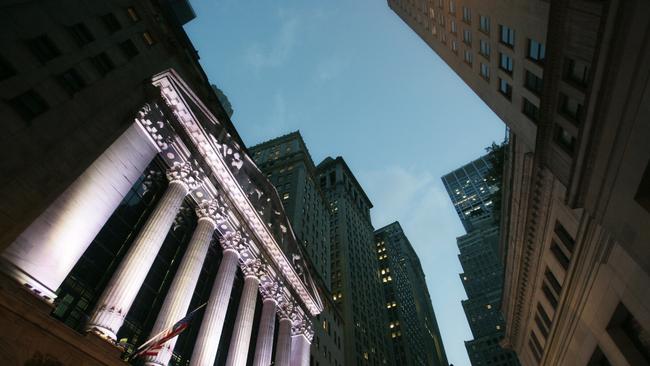Wall St sheds 2pc in its worst session since the Brexit vote
US stocks had their worst day since the Brexit after a formerly dovish Fed official started calling for a rate hike.

Stocks and bonds tumbled Friday, with the Dow industrials and S&P 500 posting their biggest percentage losses since the Brexit selloff.
Fresh signs that central banks could be backing away from easy-money policies helped boost the dollar, while investors sold shares of dividend payers like utilities and telecommunications companies that have been popular with income-seeking investors while rates have been low. Yields on some government bonds reached their highest levels since late June.
The Dow Jones Industrial Average fell 394.46 points, or 2.1 per cent, to 18085.45. The S&P 500 declined 2.45 per cent, its biggest drop since it fell 1.8 per cent on June 27, the second day of a selloff that followed the UK’s vote to leave the European Union. The Nasdaq Composite lost 2.5 per cent.
Trading volumes were elevated, traders said, something that typically suggests conviction in the market’s move.
“Today’s volume is notable because it shows people are putting money behind these moves,” said Justin Wiggs, managing director in equity trading at Stifel Nicolaus. Still, he said that wasn’t enough to convince him Friday’s declines were the start of a prolonged market slump.
“It still feels to me like a one-off,” he said.
Developed-world government debt sold off Thursday after the European Central Bank declined to pledge further stimulus. On Friday, German 10-year government bond yields turned positive for the first time since investors piled into haven investments after the Brexit vote. The yield on the 10-year US Treasury note climbed to 1.671 per cent, according to Tradeweb, marking its highest close since the UK referendum on June 23. Yields rise as prices fall.
Federal Reserve Bank of Boston President Eric Rosengren, who has in the past advocated for keeping rates low, said Friday that “a reasonable case can be made” for tightening interest rates to avoid overheating the economy. Fed governor Lael Brainard is scheduled to speak on Monday, a day ahead of the Fed’s blackout period on giving public comment before its Sept. 20-21 meeting.
Recent gains in stock markets have been underpinned by accommodative measures from the Federal Reserve, European Central Bank, Bank of England and Bank of Japan, leaving investors focused on any signs that global central bankers may be changing their tune.
Expectations for a rate increase have bounced around recently in response to economic data and comments from central bankers, though most investors still don’t expect a rate rise in September. Federal funds futures, which are used by traders to place bets on central bank policy, on Friday showed a 24 per cent chance of a US interest-rate rise in September, compared with an 18 per cent chance as of Thursday, according to CME Group.
In September, “there’s an outside chance the Fed will make a meaningful statement or action,” said Ninh Chung, head of investment strategy at SVB Asset Management, but “markets still react to almost every word a Fed official puts out.”
The WSJ Dollar Index, which measures the dollar against a basket of 16 currencies, was up 0.5 per cent, as the prospect of higher rates tends to strengthen the greenback.
The Stoxx Europe 600 fell 1.1 per cent as data showed a steep fall in German exports and after the ECB’s decision on Thursday to leave its current stimulus program unchanged frustrated many investors who expected an adjustment to its bond-buying program or hints at other measures to revive the eurozone economy.
European shares fell after the ECB announcement, while the euro gained against the dollar and the region’s sovereign bonds came under pressure. Financial shares climbed on Friday, however, as the prospect of higher interest rates tends to benefit banks’ net interest margins.
“Compared to expectations, you’d almost say [ECB President] Mario Draghi was hawkish,” said Michael Metcalfe, head of macro strategy at State Street Global Markets. Both in Europe and in Japan, “we just assumed central banks would push the quantitative easing button when things got bad again, but it seems we’ve reached the limits of that.”
In Japan, the central bank may be running out of government bonds to buy in the next 18 months or so, analysts say, with the central bank buying roughly $US750 billion worth of government debt a year. Yields on 10-year Japanese government debt rose to minus-0.021 per cent Friday.
Asian shares mostly declined, catching up with Thursday’s losses in the US and Europe. News of a fifth North Korean nuclear test further weighed on shares in the region, with stocks in Shanghai, South Korea and Australia ending lower.
Data showed China’s consumer inflation slowed in August for a fourth straight month, leaving room for further stimulus from the People’s Bank of China.
The Hang Seng gained 0.8 per cent despite wider losses in the region, after a Chinese regulator said it would allow domestic issuers to invest in Hong Kong-listed stocks through a trading link with Shanghai. The Hang Seng is among the best performers this week, up 3.6 per cent.
In commodities, US crude oil fell 3.6 per cent to $US45.88 a barrel.
Dow Jones




